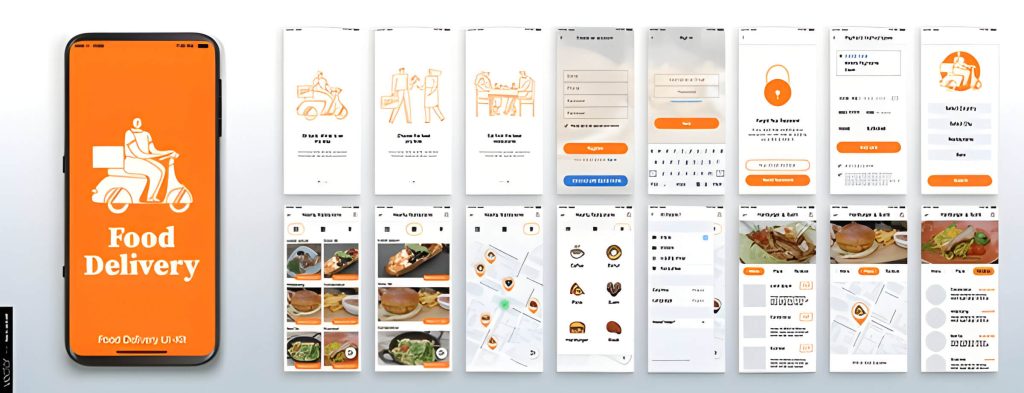Website UX/UI Design, What is it and Why is it Important for Your Online Success?

Navigating the digital realm can be a daunting task, but a well-designed website can make all the difference. In an era where online presence is paramount, understanding the intricacies of User Experience (UX) and User Interface (UI) design has become essential for businesses and individuals alike. This article explores the critical role of UX/UI design in creating engaging, user-friendly websites that not only captivate visitors but also drive conversions. By examining key components and best practices, we’ll uncover how effective design can transform your online presence and set you apart in today’s competitive digital landscape.
Understanding UX/UI Design
UX (User Experience) and UI (User Interface) design are two interconnected yet distinct disciplines in the realm of digital design. While often used interchangeably, understanding their differences is crucial for creating effective digital products.
User Experience (UX) design focuses on the overall feel of the product, emphasizing user satisfaction and ease of use. It encompasses the entire journey a user takes with a product, including aspects like information architecture, user research, and usability testing. UX designers aim to create seamless, intuitive experiences that meet user needs and expectations.
On the other hand, User Interface (UI) design concentrates on the visual elements and interactive components of a digital product. This includes buttons, icons, typography, color schemes, and layout. UI designers work to create aesthetically pleasing and functional interfaces that align with the broader UX strategy.
Key differences between UX and UI design:
1. Scope: UX is about the overall experience, while UI focuses on specific visual elements.
2. Timing: UX design typically precedes UI design in the development process.
3. Skills: UX designers need strong analytical and problem-solving skills, while UI designers require visual design expertise.
4. Tools: UX designers use wireframing and prototyping tools, whereas UI designers work with graphic design software.
Understanding these distinctions is essential for creating well-rounded digital products that not only look great but also provide an exceptional user experience. Successful web design integrates both UX and UI principles to achieve optimal results.
The Core Elements of Effective Website UX Design
User experience (UX) design is crucial for creating websites that engage and satisfy visitors. At its core, effective website UX design incorporates several key elements. User-centered design is the foundation, ensuring that all decisions are made with the end-user in mind. Information architecture plays a vital role in organizing content logically, making navigation intuitive and effortless.
Usability is another critical factor, focusing on how easily users can accomplish their goals on the site. This ties closely with accessibility, which ensures that the website is usable by people with diverse abilities and disabilities. Carefully crafted user flows guide visitors through the site, providing a seamless journey from entry to conversion.
Interaction design, the way users engage with the site’s interface, should be thoughtfully implemented to create a responsive and enjoyable experience. By integrating these core elements, designers can create websites that not only look appealing but also function efficiently, ultimately leading to higher user satisfaction and better business outcomes.
Essential Components of Engaging UI Design for Websites

When crafting an engaging user interface (UI) for websites, several essential components come into play. Visual design is the cornerstone of UI, encompassing elements that create an aesthetically pleasing and functional experience for users. Color theory plays a crucial role in this process, as the right color palette can evoke specific emotions and guide users through the interface intuitively.
Typography is another vital aspect of UI design, as it affects readability and sets the tone for the overall user experience. Choosing appropriate fonts, sizes, and spacing can significantly impact how users perceive and interact with the content.
Layout is fundamental in organizing information and guiding users through the website. A well-structured layout ensures that content is easily digestible and that important elements are prominently displayed. Implementing responsive design principles ensures that the UI adapts seamlessly to various screen sizes and devices, providing a consistent experience across platforms.
Consistency in design is key to creating a cohesive and professional-looking website. This includes maintaining uniform color schemes, typography, and visual elements throughout the site, which helps users navigate and understand the interface more easily.
By focusing on these essential components, designers can create engaging UI designs that not only look appealing but also enhance user experience and functionality.
The Impact of UX/UI Design on User Engagement and Conversion Rates
UX/UI design plays a crucial role in shaping user engagement and driving conversion rates. A well-crafted user interface not only enhances user satisfaction but also significantly reduces bounce rates. By prioritizing intuitive navigation and visually appealing layouts, businesses can create a seamless user experience that encourages visitors to explore their websites or applications further.
Effective UX/UI design is instrumental in conversion optimization. When users can easily find what they’re looking for and complete desired actions without friction, they’re more likely to convert. This could mean making a purchase, signing up for a newsletter, or requesting more information. By streamlining these processes, businesses can see a marked improvement in their conversion rates.
Moreover, a positive user experience contributes to improved customer retention. Users who enjoy interacting with a website or app are more likely to return, fostering brand loyalty. This repeated engagement can lead to increased lifetime value for customers and a stronger bottom line for businesses.
The impact of good UX/UI design extends beyond immediate metrics, influencing overall brand perception. A well-designed digital presence conveys professionalism, attention to detail, and a customer-centric approach. This positive association can enhance brand reputation and set a company apart from its competitors in the digital landscape.
UX/UI Design Best Practices for Modern Websites
When it comes to UX/UI design for modern websites, several best practices stand out. Mobile-first design has become essential, ensuring that websites are optimized for smaller screens and touch interactions. This approach not only caters to the growing mobile user base but also improves overall usability across devices.
Intuitive navigation is crucial for keeping visitors engaged. A well-structured menu, clear calls-to-action, and logical page hierarchy help users find information quickly and effortlessly. Coupled with fast page load speeds, these elements significantly reduce bounce rates and improve user satisfaction.
Minimalist design continues to dominate modern web aesthetics. By focusing on essential elements and removing clutter, designers can create visually appealing and easy-to-navigate interfaces. This approach often incorporates ample white space, which helps guide the user’s eye and creates a sense of balance and clarity.
Micro-interactions, such as subtle animations or feedback on user actions, add a layer of interactivity and polish to websites. These small details can greatly enhance the overall user experience, making interfaces feel more responsive and engaging.
By implementing these UX/UI best practices, designers can create websites that are not only visually stunning but also highly functional and user-friendly, meeting the expectations of today’s discerning web users.
Tools and Technologies for Effective UX/UI Design
In the rapidly evolving field of UX/UI design, having the right tools and technologies at your disposal is crucial for creating effective and user-friendly digital experiences. Wireframing tools like Balsamiq and Sketch allow designers to quickly create low-fidelity mockups, helping to visualize layout and structure early in the design process. For more advanced prototyping, software such as Adobe XD, Figma, and InVision enable designers to create interactive, high-fidelity prototypes that closely mimic the final product.
User testing platforms like UserTesting and Hotjar provide valuable insights into user behavior and preferences, allowing designers to make data-driven decisions. Design systems, such as Material Design and Apple’s Human Interface Guidelines, offer comprehensive frameworks for creating consistent and cohesive designs across various platforms and devices.
Collaboration tools like Zeplin and Abstract facilitate seamless communication between designers and developers, ensuring that design intentions are accurately translated into the final product. These tools allow for easy sharing of design specs, assets, and version control, streamlining the handoff process.
By leveraging these powerful tools and technologies, UX/UI designers can enhance their workflow, improve collaboration, and ultimately create more intuitive and engaging digital experiences for users.
Measuring the Success of Your Website’s UX/UI Design
Measuring the success of your website’s UX/UI design is crucial for continuous improvement and ensuring optimal user experience. Several effective methods can provide valuable insights into your design’s performance.
User feedback is a direct way to gauge satisfaction and identify pain points. Implement surveys, feedback forms, or user interviews to collect qualitative data about the user experience.
Analytics tools offer quantitative data on user behavior. Track metrics such as bounce rate, time on page, and conversion rates to understand how users interact with your site.
A/B testing allows you to compare different design elements by presenting variations to different user groups. This method helps determine which design choices lead to better performance.
Heatmaps provide visual representations of user interactions, showing where users click, scroll, and focus their attention. This information can highlight areas of interest or confusion in your design.
User behavior analysis goes beyond basic analytics, examining user journeys and interactions in detail. This can reveal patterns and potential areas for improvement in your UX/UI design.
Finally, establish key performance indicators (KPIs) specific to your website’s goals. These might include task completion rates, user satisfaction scores, or specific conversion metrics. Regularly monitor these KPIs to track the overall success of your UX/UI design and guide future improvements.
Investing in UX/UI Design for Long-Term Online Success
Investing in UX/UI design is not just a short-term strategy; it’s a crucial component for long-term online success. As we’ve explored throughout this article, a well-designed user interface coupled with a seamless user experience can significantly impact your website’s performance, user satisfaction, and ultimately, your bottom line.
By prioritizing UX/UI design, you’re not only enhancing the visual appeal of your digital presence but also creating a more efficient, enjoyable, and memorable experience for your users. This investment can lead to increased user engagement, higher conversion rates, and improved customer loyalty.
Remember that UX/UI design is an ongoing process. As technology evolves and user expectations change, it’s essential to continually assess and refine your design approach. Stay informed about the latest trends, gather user feedback, and be willing to adapt your strategies to meet the changing needs of your audience.
The businesses that recognize the value of UX/UI design and commit to its implementation will be better positioned to thrive in the competitive digital landscape. By putting your users first and creating intuitive, attractive, and functional interfaces, you’re setting the foundation for sustainable online success.